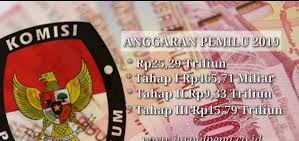Indonesia had just passed the “hot” atmosphere, especially in politics. In 2019, Indonesia held a general election which was run once in five years to choose a leader for this country.
In that year, the Indonesian people, not only the inhabitants of famous cities in Indonesia but also in other regions, voted for both presidential and legislative election. It happened on April 17, 2019.
There were unique and distinct facts about the 2019 Indonesian general election you need to know.
1. Held simultaneous legislative and presidential elections in one day.

Since 2004 until the previous 2014 elections, facts about the Indonesian government stated Indonesia held the legislative elections for regional legislative council (DPRD) members, House of Representatives, Regional Representatives Council (DPD), and Indonesian Legislative Assembly (DPR) three months prior to the presidential elections.
However, in the 2019 elections, those elections were held together in one day!
The Lowy Institute, an independent think tank based in Sydney, Australia, stated that this 2019 Indonesian election is “one of the most complicated single-day elections in global history”.
2. The increasing of the election budget.

Being influenced by the one-day election, the budget allocation amounted to IDR 25,59 trillion.
The number significantly grew up to IDR 1,49 trillion compared to the previous election in 2014 that was up to IDR 24,1 trillion.
This amount of money was used for three categories which are supporting activities like security, implementation, and supervision.
However, Director-General of Budget Askolani informed that these elections were merged, it effectively cut some double expense when the election was held separately.
Some cost-effective budgets were used for witnesses and ballot boxes.
3. The million voters.

The General Elections Commission announced the voters were over 192 million people. Among those people, 3,500 voters were having mental health issues.
Around 80 million, 40 percent of the eligible voters, were Millenials or people in 17 to 35 years old.
It was time for young people to determine their future through their choice in the 2019 election.
In this election, the winner of the presidential election, Joko Widodo, created a new history in the Indonesian election.
His number of voters, 85 million people, exceeded the previous president, Susilo Bambang Yudhoyono who “only” received 73 million voters in the 2009 election.
4. Jokowi and Prabowo’s Second competition.

One of the facts about the 2019 Indonesian general election is that this is the second battle between Joko Widodo and Prabowo Subianto.
They met in the previous election, in 2014, and Jokowi was chosen by the people to become the first person in Indonesia for 2014 until 2019.
Joko Widodo (Jokowi), who has made the history of Indonesia economic growth better, is accompanied by Ma’ruf Amin, a powerful cleric in Indonesia who is the head of the Indonesian Ulama Council (MUI) and the senior of the Nahdlatul Ulama, a major Islamic organization, in running for the presidential election.
Jokowi’s decision to choose Ma’ruf Amin as his vice president surprised many people in Indonesia as Ma’ruf Amin played an important role in the protests for the downfall of Ahok, Jokowi’s previous mate when he became the Governor of Jakarta, who is also one of the most popular persons in Indonesia.
Prabowo Subianto is popular for the political inheritance from the traditional political elite as he was married to the daughter of the second president of Indonesia, General Suharto.
Unlike Jokowi who chose a cleric, Prabowo picked Sandiaga Uno, one of the richest men in Indonesia who is also a young politician, as his mate for the vice-presidential candidate.
5. Sixteen parties competed.

Sixteen parties, including four new parties – Indonesia’s Solidarity Party (PSI), Berkarya Party, Garuda Party, and Perindo – were competing to get people’s hearts.
The five parties who earned the biggest percentage of voters in DPR election were PDI-P that finished first place with 19.33%, Gerindra was in the second place with 12.57%, followed by Golkar with 12.31%.
Then the National Awakening Party (PKB) with 9.69%, then the Nasdem Party with 9.05%, and the last was the Prosperous Justice Party (PKS) with 8.21%.
The Jokowi’s party PDI-P and Prabowo’s party Gerindra ranked in the first and second place.
6. Fighting against hoax.

The Indonesian organization fighting fake news, Mafindo, stated there was 61 percent of political disinformation and fake news or hoax from December 2018 until January 2019.
The majority of the fake news was mainly focused on the misinformation of Jokowi’s position. It said that Jokowi converts himself to be a Christian, or he claims as Chinese ancestry and a communist.
It might not seem to be another political drama, but facts about Indonesian religion are that Indonesia has more than 80 percent of Moslems even though it is not the official state religion and has experienced traumatized events about communism in 1965.
Therefore, the fake news mentioned was a sensitive issue as it is strongly related to the ideology and majority of religion in Indonesia.